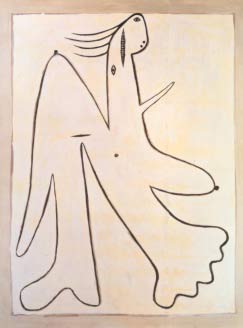
Picasso / Artists Rights Society (ARS), New York
Picasso Black and White has all the ingredients of a blockbuster exhibition. The featured artworks are historically significant examples from the best known periods of the artist’s work installed chronologically. It’s a broad overview of Picasso’s 75-year career, moving sequentially through the blue period, cubism, neo-classicism, studies for Guernica, takes on the Spanish masters and finally a gallery of works made when the artist was in his 80s and 90s. The artworks range in scale from showstoppers such as the bronze Woman with a Vase (1933) and large canvas The Charnel House (1944-1945), to small cubist studies in graphite on paper.

The reason why Picasso worked in black and white throughout his life and in so many formats is left as an open question. The curator Carmen Giménez offers a range of possibilities in her catalogue essay, from the artist’s proclivity for working at night to a connection to his spirit through shadows. Two of Picasso’s most important contributions to art history—analytical cubism and Guernica—were mostly monochromatic, suggesting that the artist worked in reduced palettes when he had something serious to say. Of these two breakthroughs, the exhibition is weighted more toward Guernica, which Giménez admits has personal significance to her as her father was a Spanish Republican whose sympathies therefore lay with Picasso’s grand painting.

Standing Woman (Femme en pied) (1927), oil on canvas, 133 x 105 centimeters. Marina Picasso Collection (Inv. 12471), courtesy Jan Krugier Gallery, New York
Giménez’s many years of curating Picasso exhibitions and working with his descendants allowed her to secure loans from Picasso family members that have rarely appeared in museums. One third of the exhibition comes from the artist’s estate, and many of the works are revelations. I especially enjoyed the second gallery, labeled “surrealism,” that features a series of portraits of women from 1927/28, presumably inspired by the artist’s lover Marie-Thérèse Walter. In works such as Standing Woman (1927), her elongated limbs are contorted into grotesque sorts of arabesques in multiple configurations that rise with lightness, yet sink to the ground in flat, crippled arms and feet. Shown in stark black outline on white canvas, the slits and holes of her eyes, mouth and vagina are mixed up in a frightening distortion. Picasso discerns an iconic power in the strange shapes that make Walter like the cycladic goddesses featured in the MFAH’s green-walled ancient art galleries adjacent to the exit of the exhibition.

Picasso’s confident use of bold lines to define masses that have a strong weight, yet seem to dance and almost float in space comes through particularly strongly in this exhibition. In Picasso’s hands, the color black marks edges, voids and heavy forms as in The Milliner’s Workshop (1926); and white can alternately be vacant, claustrophobic, ethereal and grounded, an ambiguity used to stunning effect in Woman in White (1923). The sculptures sprinkled throughout the galleries show in three-dimensional space what Picasso is also able to achieve on the surface of paper, canvas, or wood. A bronze that appears toward the end of the exhibition stands out—a skull from 1943. Its lumpy mass is almost formless and relic-like, as if the artist dug it from a grave or archaeological site. Yet the brutally carved round holes for eyes appear to sink to infinity even as they bore into whomever meets their gaze. It may give me nightmares for days to come.
![Pablo Picasso, Skull (Le crâne [Tête de mort]), Grands-Augustins, Paris, 1943. Bronze, 25 x 21 x 33 cm. One of two unnumbered proofs. Private collection. © 2012 Estate of Pablo Picasso/Artists Rights Society (ARS), New York. Photo: Maurice Aeschimann](http://glasstire.com/wp-content/uploads/2013/02/picasso_x_2009_1439_m.jpg)
The austere effect of gallery after gallery of works in ranges of grey are reason enough to show the artworks together. But as enjoyable as the visual unity of the exhibition is, it does not have a sense of unfolding discoveries. The organization of the galleries relies too heavily on a historical periodization of Picasso, rather than grouping works in unexpected and surprising ways. As Picasso himself said in a 1956 interview, “I have a horror of people who speak about the beautiful. What is the beautiful? One must speak of problems in painting! Paintings are but research and experiment. I never do a painting as a work of art. All of them are researches.” The works in the MFAH are evidence of Picasso’s investigations, but the exhibition itself is remarkably free of problems.
There have been a number of exhibitions over the last five years that have looked at “masters” of twentieth century art through the lens of color—for example Jasper Johns: Gray, Color Chart: Reinventing Color 1950 to Today and locally James Drake: Red Drawings and White Cutouts. The subjects of these chromatic-based studies are mostly white men whose position in the pantheon is all but assured. I wonder whether paring their work down to issues of tint and gradation might be a clever way to push any criticality out of consciousness? At least in this case, I am not convinced that focusing on artworks where Picasso did not use color offers a new perspective on his work.

collection. © 2013 Estate of Pablo Picasso / Artists Rights Society (ARS), New York
Picasso Black and White is on display at Museum of Fine Arts, Houston through May 27.
Entry will require a ticket. Admission details and on-sale date for tickets are on the exhibition website.
Rachel Hooper is pursuing a doctorate in art history at Rice University, where she is a graduate student fellow with the Humanities Research Center. She is also a participant in the 2012 Art Writing Workshop organized by the International Art Critics Association/USA Section (AICA/USA) and the Creative Capital | Warhol Foundation Arts Writers Grant Program, for which her mentor is Raphael Rubinstein.


